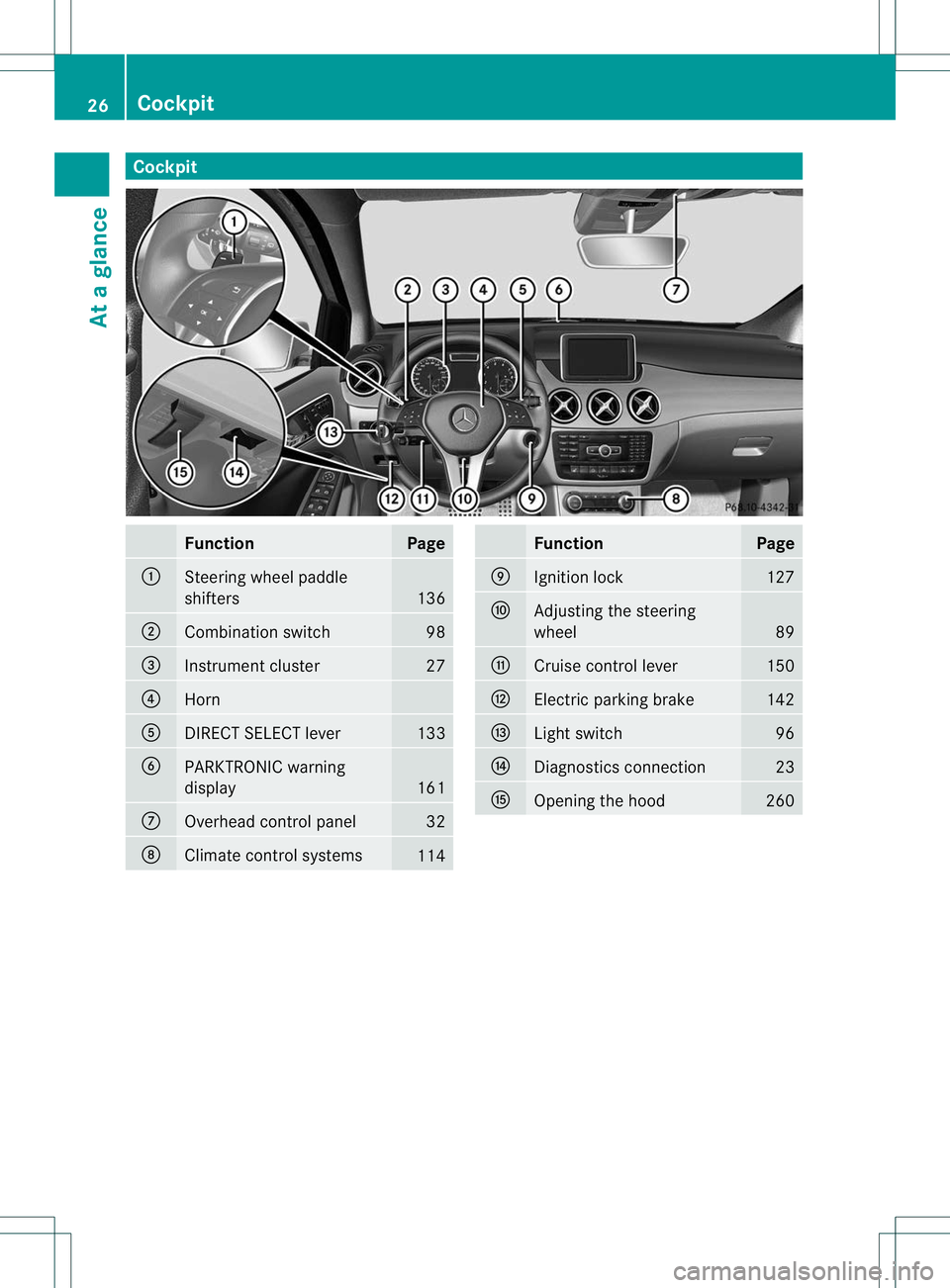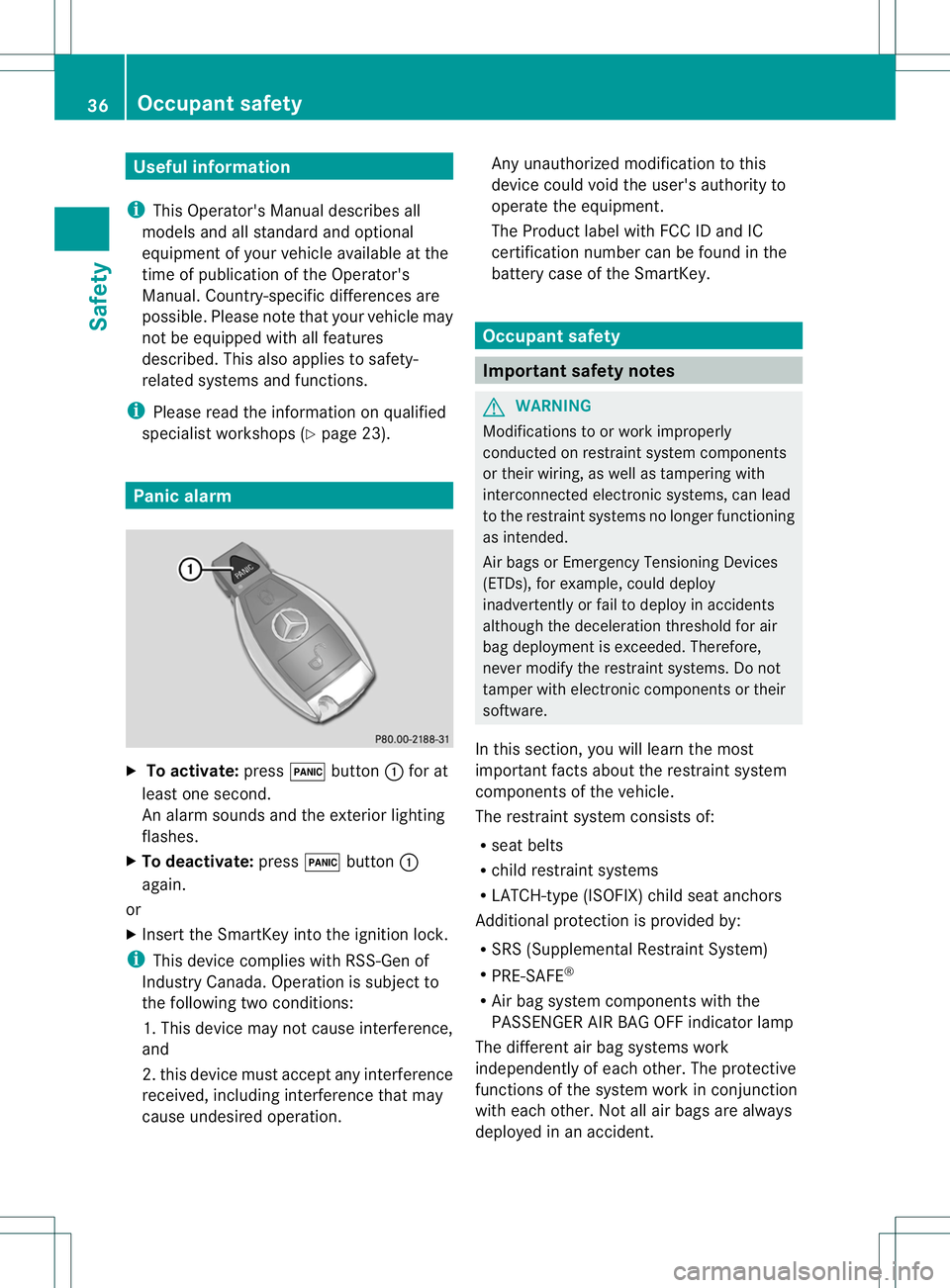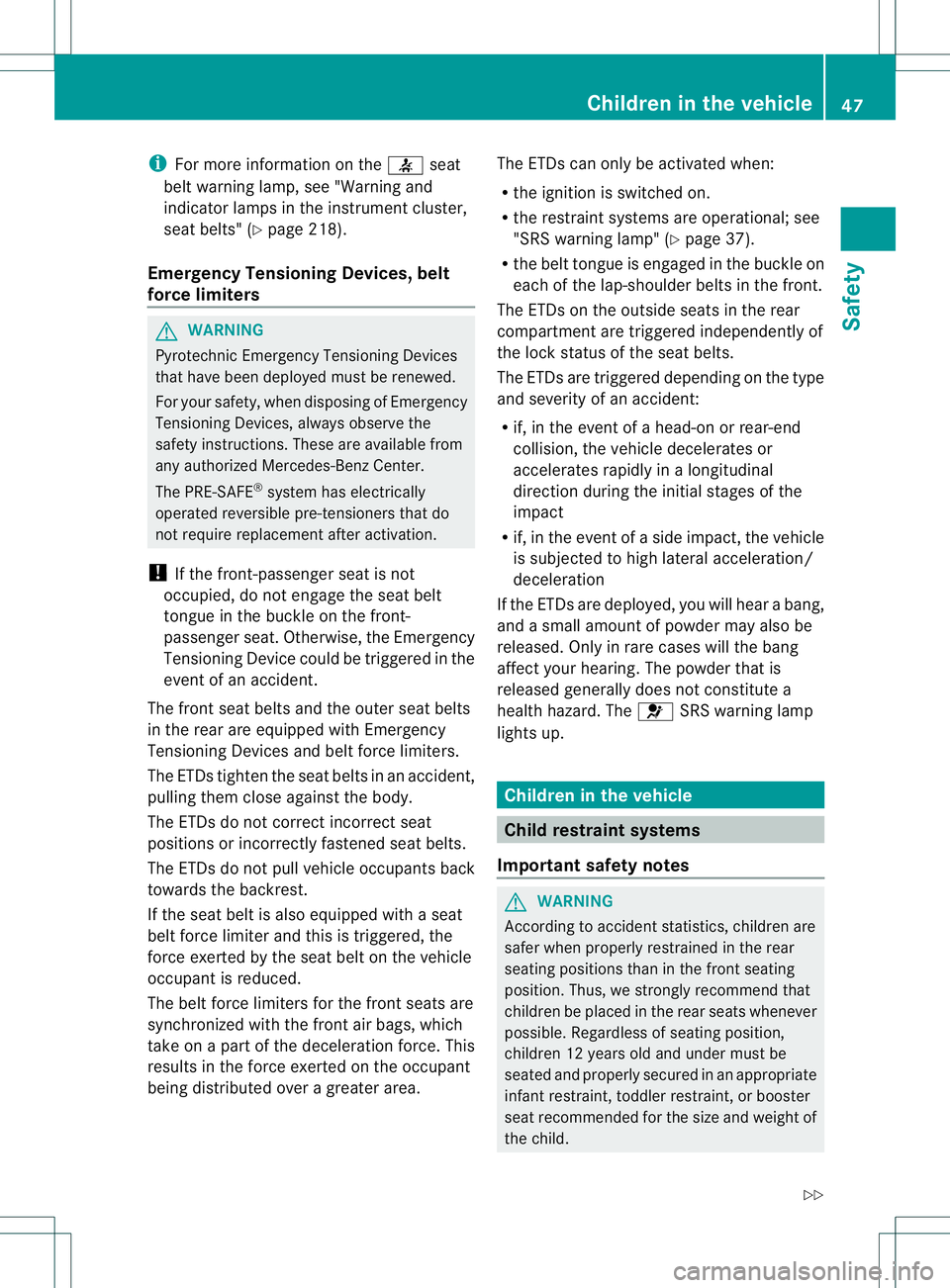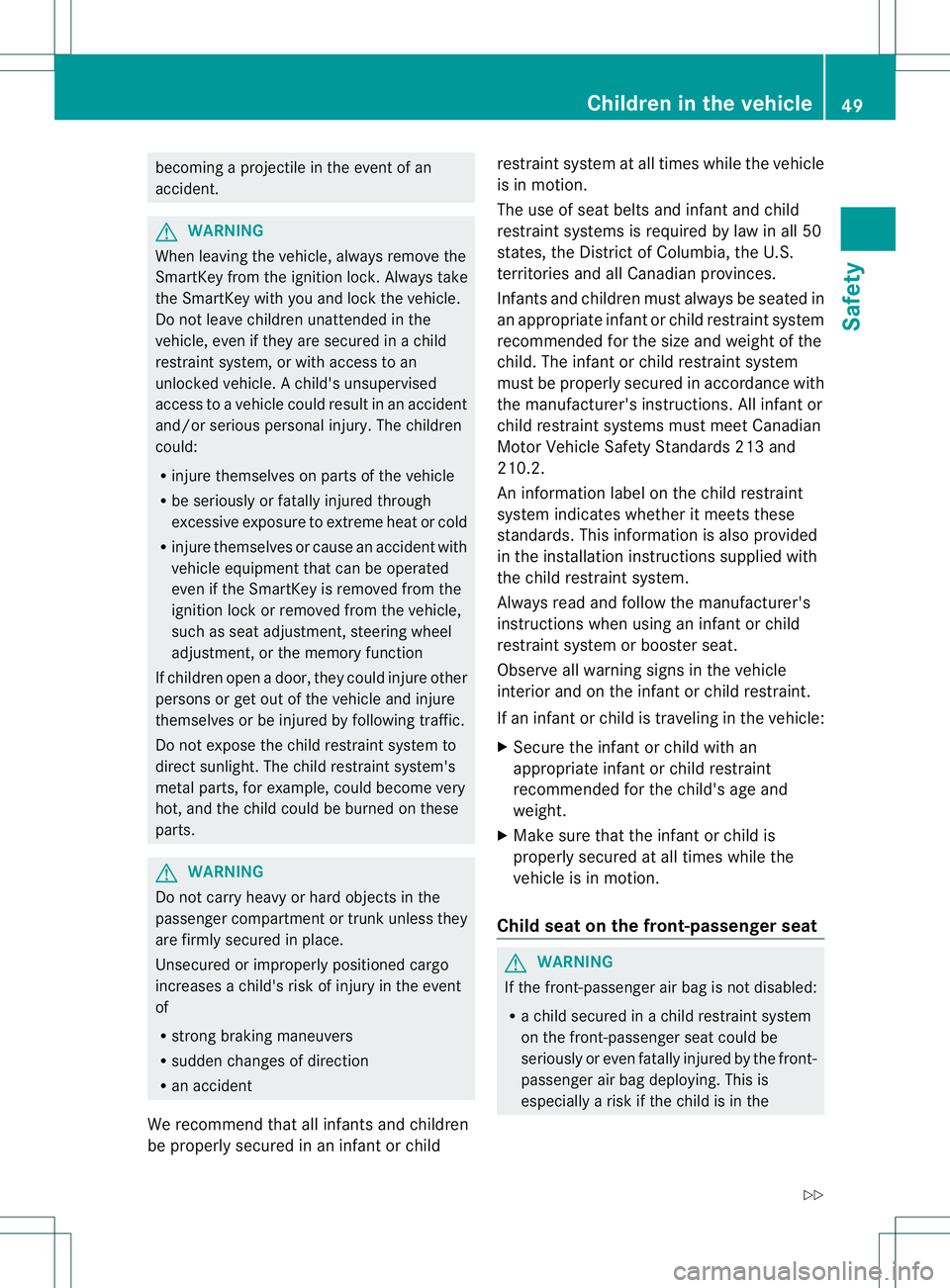2013 MERCEDES-BENZ B-CLASS SPORTS ignition
[x] Cancel search: ignitionPage 14 of 336

Hydroplaning
..................................... 149I
Ignition lock see Key positions
Immobilizer .......................................... 65
Indicator lamps see Warning and indicator lamps
Instrument cluster
Overview .......................................... 27
Settings ......................................... 189
Warning and indicator lamps ...........28
Instrument cluster lighting ..............178
Interior lighting ................................. 101
Automatic control ..........................102
Delayed switch-off (on-board
computer) ...................................... 191
Emergency lighting ........................102
Manual control ............................... 102
Overview ........................................ 101
Reading lamp ................................. 101
Interior motion sensor ........................66 J
Jack Storage location ............................ 274
Using ............................................. 313
Jump starting (engine) ......................283 K
Kickdown Driving tips .................................... 135
Manual drive program ....................137
Knee bag .............................................. 42L
Lamps see Warning and indicator lamps
Lane Keeping Assist
Activating/deactivating .................188
Display message ............................ 210
Function/informatio n.................... 174
Lane Tracking package .....................173
LATCH-type (ISOFIX) child seat
anchors ................................................ 51License plate lamp
Changing bulbs .............................. 109
License plate lamp (display
message) ............................................ 204
Light function ,active
Display message ............................ 205
Lights
Activating/deactivating the
interio rlighting delayed switch-off .191
Automatic headlamp mode ..............97
Cornering light function ...................99
Display message ............................ 202
Driving abroad ................................. 96
Fog lamps ........................................ 97
Fog lamps (extended) ....................100
Hazard warning lamps .....................99
High beamf lasher ............................ 99
High-beam headlamps .....................98
Ligh tswitc h..................................... 96
Low-beam headlamps ......................97
Parking lamps .................................. 98
Rea rfog lamp .................................. 98
Standing lamps ................................ 98
Switching Adaptive Highbeam
Assist on/off ................................. 190
Switching the daytime running
lamps on/off (on-board
computer) ...................................... 190
Switching the daytime running
lamps on/off (switch) ......................97
Switching the exterio rlighting
delayed switch-off on/off (on-
board computer )............................ 190
Switching the surround lighting
on/off (on-board computer) ..........190
Turn signals ..................................... 98
see Changing bulbs
see Interior lighting
Light sensor (display message) .......205
Loading guidelines ............................230
Locking see Centra llocking
Locking (doors)
Automatic ........................................ 74
Emergency locking ........................... 75
From inside (central locking
button) ............................................. 74 Index
11
Page 18 of 336

Adjusting the 4-way lumbar
support
............................................ 88
Adjusting the head restraint ............87
Cleaning the cover .........................270
Correct driver's seat position ........... 84
Important safety notes ....................85
Seat heating problem ......................89
Storing settings (memory
function) .......................................... 93
Switching sea theating on/off .........89
Sensors (cleaning instructions) .......269
Service see ASSYST PLUS
Service menu (on-board computer) .189
Service products Brake fluid ..................................... 327
Coolant (engine) ............................ 327
Engine oil ....................................... 326
Fuel ................................................ 324
Important safety notes ..................324
Washer fluid .................................. .328
Service work
see ASSYST PLUS
Settings
Factory (on-board computer) .........192
On-board computer .......................189
Setting the air distribution ...............120
Setting the airflow ............................120
Side impact air bag .............................42
Side marker lamp (display
message) ............................................ 205
Side windows Cleaning ......................................... 268
Convenience closing feature ............78
Convenience opening feature ..........78
Important safety information ...........77
Opening/closing .............................. 78
Problem (malfunction) .....................79
Resetting ......................................... 79
Sliding sunroof
see Panorama roof with power
tilt/sliding panel
SmartKey
Changing the battery .......................70
Changing the programming .............69
Checking the battery .......................70
Convenience closing feature ............78
Convenience opening feature ..........78 Display message
............................ 218
Door central locking/unlocking .......68
Important safety notes ....................68
Loss ................................................. 72
Mechanical key ................................ 69
Positions (ignition lock) .................127
Problem (malfunction) .....................72
Starting the engine ........................127
SmartKey positions (ignition lock) ..127
Snow chains ...................................... 295
Sockets Center console .............................. 244
Luggage compartment ...................245
Points to observe before use .........244
Rea rcompartmen t......................... 245
Specialist workshop ............................ 23
Speed, controlling see Cruise control
Speedometer
Activating/deactivating the
additional speedometer .................189
Digita l............................................ 183
In the Instrument cluster .................27
Segments ...................................... 179
Selecting the unit of
measurement ................................ 189
see Instrument cluster
SRS (Supplemental Restraint
System)
Display message ............................ 201
Introduction ..................................... 37
Warning lamp ................................. 225
Warning lamp (function) ................... 37
Standing lamps
Changing bulbs .............................. 105
Display message ............................ 204
Switching on/off .............................. 98
Starting (engine) ................................ 127
STEE RCONTROL .................................. 64
Steering (display message) ..............217
Steering wheel Adjusting (manually). .......................89
Button overview ............................... 29
Buttons (on-board computer) ......... 180
Cleaning ......................................... 270
Important safety notes ....................89
Paddle shifters ............................... 136
Steering wheel paddle shifters ........136 Index
15
Page 29 of 336

Cockpit
Function Page
:
Steering wheel paddle
shifters
136
;
Combination switch 98
=
Instrument cluster 27
?
Horn
A
DIRECT SELECT lever 133
B
PARKTRONIC warning
display
161
C
Overhead control panel 32
D
Climate control systems
114 Function Page
E
Ignition lock 127
F
Adjusting the steering
wheel
89
G
Cruise control lever 150
H
Electric parking brake 142
I
Ligh
tswitch 96
J
Diagnostics connection 23
K
Opening the hood 26026
CockpitAt a glance
Page 39 of 336

Useful information
i This Operator's Manual describes all
models and all standard and optional
equipment of your vehicle available at the
time of publication of the Operator's
Manual. Country-specific differences are
possible. Please note that your vehicle may
not be equipped with all features
described. This also applies to safety-
related systems and functions.
i Please read the information on qualified
specialist workshops (Y page 23).Panic alarm
X
To activate: press!button :for at
least one second.
An alarm sounds and the exterior lighting
flashes.
X To deactivate: press!button :
again.
or
X Insert the SmartKey into the ignition lock.
i This device complies with RSS-Gen of
Industry Canada. Operation is subjec tto
the following two conditions:
1. This device may not cause interference,
and
2. this device must accep tany interference
received, including interference tha tmay
cause undesired operation. Any unauthorized modificatio
nto this
device could void the user's authority to
operate the equipment.
The Product label with FCC ID and IC
certification number can be found in the
battery case of the SmartKey. Occupant safety
Important safety notes
G
WARNING
Modifications to or work improperly
conducted on restraint system components
or their wiring, as well as tampering with
interconnected electronic systems, can lead
to the restraint systems no longer functioning
as intended.
Air bags or Emergency Tensioning Devices
(ETDs), for example, could deploy
inadvertently or fail to deploy in accidents
although the deceleration threshold for air
bag deployment is exceeded. Therefore,
never modify the restraint systems. Do not
tamper with electronic components or their
software.
In this section, you will learn the most
important facts about the restraint system
components of the vehicle.
The restraint system consists of:
R seat belts
R child restraint systems
R LATCH-type (ISOFIX) child seat anchors
Additional protection is provided by:
R SRS (Supplemental Restraint System)
R PRE-SAFE ®
R Air bag system components with the
PASSENGER AIR BAG OFF indicator lamp
The different air bag systems work
independently of each other. The protective
functions of the system work in conjunction
with each other. Not all air bags are always
deployed in an accident. 36
Occupant safetySafety
Page 40 of 336

i
For information on infants and children
traveling with you in the vehicle restraint
systems for infants and children, see
"Childrenint he vehicle" (Y page 47). SRS (Supplemental Restraint System)
Introduction SRS consists of:
R
the 6 SRS warning lamp
R air bags
R air bag control unit (with crash sensors)
R Emergency Tensioning Devices for the
front seat belts and the outer seat belts in
the rear
R seat belt force limiters for the front seat
belts and the outer seat belts in the rear
SRS reduces the risk of occupants coming
into contact with the vehicle's interior in the
event of an accident. It can also reduce the
effect of the forces to which occupants are
subjected during an accident.
SRS warning lamp G
WARNING
The SRS self-check has detected a
malfunction if the 6SRS indicator lamp:
R does not light up at all
R does not go out after approximately four
seconds after the engine is started
R lights up after the engine is started or while
the vehicle is in motion
For your safety, Mercedes-Ben zstrongly
recommends tha tyou have the system
checked as soon as possible at a qualified
specialist workshop. SRS may otherwise fail
to activate when it is needed in the event of
an accident, which could lead to serious or
fatal injuries. SRS might also be activated
unexpectedly and unnecessarily, which could
also result in injury.
In addition, work carried out improperly on
SRS may render SRS inoperative or cause unintended air bag deployment. Work on the
SRS system should only be carried out by
qualified specialist personnel. Consult a
qualified specialist workshop.
If it is necessary to modify an air bag system
to accommodate a person with disabilities,
contact an authorized Mercedes-Benz Center
for details. USA only: for further information,
contact our Customer Assistance Center at
1-800-FOR-MERCedes (1-800-367-6372).
The 6 SRS warning lamp in the instrument
cluster lights up when the ignition is switched
on. It goes out no later than a few seconds
after the engine is started.
SRS functions are checked regularly when the
engine is running. Therefore, malfunctions
can be detected in good time.
The SRS components are in operational
readiness when the 6SRS warning lamp
goes out while the engine is running.
Triggering of Emergency Tensioning
Devices (ETDs), belt force limiters and
air bags During the first stage of a collision, the air bag
control unit evaluates important physical
data relating to vehicle deceleration or
acceleration, such as:
R
duration
R direction
R magnitude
Based on the evaluation of this data, the air
bag control unit pre-emptively triggers the
belt tensioners in the first stage.
If there is an even higher rate of vehicle
deceleration or acceleration in a longitudinal
direction, the front air bags are also deployed.
Your vehicle has adaptive, two-stage front air
bags. The air bag control unit evaluates
vehicle deceleration or acceleration in the
event of a collision. In the first deployment
stage, the front air bag is filled with enough
propellant gas to reduce the risk of injuries.
The front air bag is fully deployed if a second Occupant safety
37Safety Z
Page 50 of 336

i
For more information on the 7seat
bel tw arning lamp, see "Warning and
indicator lamps in the instrument cluster,
seat belts" ( Ypage 218).
Emergency Tensioning Devices, belt
force limiters G
WARNING
Pyrotechnic Emergency Tensioning Devices
that have been deployed must be renewed.
For your safety, when disposing of Emergency
Tensioning Devices, always observe the
safety instructions. These are available from
any authorized Mercedes-Ben zCenter.
The PRE-SAFE ®
system has electrically
operated reversible pre-tensioners that do
not require replacement after activation.
! If the front-passenger seat is not
occupied, do not engage the seat belt
tongue in the buckle on the front-
passenger seat. Otherwise, the Emergency
Tensioning Device could be triggered in the
event of an accident.
The fron tseat belts and the outer seat belts
in the rear are equipped with Emergency
Tensioning Devices and belt force limiters.
The ETDs tighten the seat belts in an accident,
pulling them close against the body.
The ETDs do not correct incorrect seat
positions or incorrectly fastened seat belts.
The ETDs do not pull vehicle occupants back
towards the backrest.
If the seat belt is also equipped with a seat
belt force limiter and this is triggered, the
force exerted by the seat belt on the vehicle
occupan tis reduced.
The belt force limiters for the front seats are
synchronized with the front air bags, which
take on a part of the deceleration force. This
results in the force exerted on the occupant
being distributed over a greater area. The ETDs can only be activated when:
R
the ignition is switched on.
R the restraint systems are operational; see
"SRS warning lamp" (Y page 37).
R the belt tongue is engaged in the buckle on
each of the lap-shoulder belts in the front.
The ETDs on the outside seats in the rear
compartment are triggered independently of
the lock status of the seat belts.
The ETDs are triggered depending on the type
and severity of an accident:
R if, in the event of a head-on or rear-end
collision, the vehicle decelerates or
accelerates rapidly in a longitudinal
direction during the initial stages of the
impact
R if, in the event of a side impact, the vehicle
is subjected to high lateral acceleration/
deceleration
If the ETDs are deployed, you will hear a bang,
and a small amount of powder may also be
released.O nly in rare cases will the bang
affect your hearing .The powder that is
released generally does not constitute a
health hazard. The 6SRS warning lamp
lights up. Children in the vehicle
Child restraint systems
Important safety notes G
WARNING
According to accident statistics, children are
safer when properly restrained in the rear
seating positions than in the front seating
position. Thus, we strongly recommend that
children be placed in the rear seats whenever
possible. Regardless of seating position,
children 12 years old and under must be
seated and properly secured in an appropriate
infant restraint, toddler restraint, or booster
seat recommended for the size and weight of
the child. Children in the vehicle
47Safety
Z
Page 52 of 336

becoming a projectile in the event of an
accident.
G
WARNING
When leaving the vehicle, always remove the
SmartKey from the ignition lock. Always take
the SmartKey with you and lock the vehicle.
Do not leave children unattended in the
vehicle, even if they are secured in a child
restraint system, or with access to an
unlocked vehicle. Achild's unsupervised
access to a vehicle could result in an accident
and/or serious personal injury. The children
could:
R injure themselves on parts of the vehicle
R be seriously or fatally injured through
excessive exposure to extreme heat or cold
R injure themselves or cause an accident with
vehicle equipment that can be operated
even if the SmartKey is removed from the
ignition lock or removed from the vehicle,
such as seat adjustment, steering wheel
adjustment, or the memory function
If children open a door, they could injure other
persons or get out of the vehicle and injure
themselves or be injured by following traffic.
Do not expose the child restraint system to
direct sunlight. The child restraint system's
metal parts, for example, could become very
hot, and the child could be burned on these
parts. G
WARNING
Do not carry heavy or hard objects in the
passenger compartmentort runk unless they
are firmly secured in place.
Unsecured or improperly positioned cargo
increases a child's risk of injury in the event
of
R strong braking maneuvers
R sudden changes of direction
R an accident
We recommend that all infants and children
be properly secured in an infant or child restraint system at all times while the vehicle
is in motion.
The use of seat belts and infant and child
restraint systems is required by law in all 50
states, the District of Columbia, the U.S.
territories and all Canadia
nprovinces.
Infants and children must always be seated in
an appropriate infant or child restraint system
recommended for the size and weight of the
child .The infant or child restraint system
must be properly secured in accordance with
the manufacturer's instructions. All infant or
child restraint systems must meet Canadian
Motor Vehicle Safety Standards 213 and
210.2.
An information label on the child restraint
system indicates whether it meets these
standards. This information is also provided
in the installation instructions supplied with
the child restraint system.
Always read and follow the manufacturer's
instructions when using an infant or child
restraint system or booster seat.
Observe all warning signs in the vehicle
interior and on the infant or child restraint.
If an infant or child is traveling in the vehicle:
X Secure the infant or child with an
appropriate infant or child restraint
recommended for the child's age and
weight.
X Make sure that the infant or child is
properly secured at all times while the
vehicle is in motion.
Child seat on the front-passenger seat G
WARNING
If the front-passenger air bag is not disabled:
R a child secured in a child restraint system
on the front-passenger seat could be
seriously or even fatally injured by the front-
passenger air bag deploying. This is
especially a risk if the child is in the Children in the vehicle
49Safety
Z
Page 54 of 336

cannot perform its intended protective
function in the event of an accident, and could
lead to injuries.
G
WARNING
Do not place electronic devices on the front-
passenger seat, e.g.:
R laptops, whe nswitched on
R mobile phones
R cards with transponders, e.g .ski passes or
access cards
Signals from electronic equipment can cause
interference in the sensor system of the air
bag deactivatio nsystem. This can lead to a
system malfunction .This may cause the
4 PASSENGER AIR BAG OFF indicator
lamp to light up even if no child seat with a
transponder for an air bag deactivation
system is installed. The front-passenger air
bag would not then deploy during an accident.
It is also possible that the 6SRS warning
lamp lights up and/or the 4PASSENGER
AIR BAG OFF indicator lamp does not light up
briefly when you turn the key in the ignition
lock to position 2. The sensor system of the air bag deactivation
system on the front-passenger seat detects
whether a special Mercedes-Ben
zchild seat
has been installed there. To support
detection by the sensor system, the
Mercedes-Benzc hild seat is equipped with
transponders for the air bag deactivation
system. In this case, the 45:indicator lamp lights up. The front-passenger
air bag is deactivated.
i
If the front-passenger air bag is
deactivated by the air bag deactivation
system, the following remain enabled on
the front-passenger side:
R the side impact air bag
R the window curtain air bag
R the Emergency Tensioning Device
LATCH-type (ISOFIX) child seat anchors
in the rear G
WARNING
Children that are too large for a child restraint
must travel in seats using normal seat belts.
Position the shoulder belt across the chest
and shoulder, not face or neck.
Ab ooster seat may be necessary to achieve
proper seat belt positioning for children over
41 lb (18 kg) until they reach a height where
a lap/shoulder belt fits properly without a
booster.
Install the child restraint system in
accordance with the manufacturer's
instructions.
Attach the child restraint system to both
securing rings.
An incorrectly installed child restraint system
could come loose during an accident and
seriously or even fatally injure the child.
Child restraint systems or child seat securing
rings that are malfunctioning or damaged as
the result of a collision must be replaced.
! When installing the child restraint system,
make sure that the seat belt for the middle
seat does not get trapped. The seat belt
could otherwise be damaged. Children in the vehicle
51Safety Z